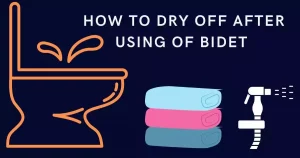Bidet Flooding: Causes of Bidet Flooding, What to Do and How to Prevent it.

Everyone using a bidet have a concern regarding a bidet flooding. The problem of bathroom or bidet flooding is relatively common. In fact, in homes, most water is used in the bathroom. So it listens to many people losing hundreds of gallons of water that happened with the flooding of a bidet in their bathroom.
How does a bidet work?
In general, there are two types of bidets: hands-free and handheld. North American bidets have predominantly hands-free designs, including popular brands such as Tushy.
Bidets are easy to use and are easy to keep clean. The first thing you want to do is to use the toilet as you normally would.
The next thing you need to do is to turn on the bidet using the controls that are located on the side of the toilet. There will be an immediate spray of water if it is a non-electronic sprayer. There is usually a switch that allows you to adjust the spray angle, so it hits the right spots for cleaning. In addition, there is another one that allows you to adjust the pressure of the water.
When you press the on-button of an electronic bidet, the spray usually starts only after a short delay after pressing the on-button. Bidet spray nozzles have to extend, and heated water takes a few seconds to warm.
It is advisable to turn off the bidet once you feel clean enough. You can clean the spray nozzle of y our bidet after you are finished using it if it has this feature.
After you finish, many electronic bidets have a built-in dryer, so you only have to press a button to dry, and in the case of a manual bidet or bidet that does not have a dryer, you can dry yourself with a small amount of toilet paper.

Can a bidet cause plumbing problems?
Oh, absolutely! Bidets can sometimes cause plumbing problems, especially if they’re leaking water.
One common issue is a bidet leaking water, which can be quite frustrating. You might have noticed a puddle forming around your bidet or even discovered water dripping from it. This can happen due to various reasons like a faulty valve, loose connections, or worn-out seals.
Now, when water starts escaping where it shouldn’t, it can lead to bigger plumbing headaches. The excess water can seep into the floor, causing damage to the subfloor, tiles, and even the ceiling below if you’re using an upper-level bathroom.
Plus, if the leak persists, it can waste a significant amount of water, resulting in higher utility bills. It’s crucial to address the issue promptly to avoid further damage and expenses.
Unleashing the story of my Tushy bidet's leaky surprise:
As a lover of bidets, about six months ago, I bought a Tushy bidet attachment for my bathroom’s existing toilet. Soon after a week of use, I noticed the leak in my Tushy bidet and immediately addressed the issue.
First, I turned off the bidet’s water supply to prevent further leaking. With the water flow stopped, I carefully examined the bidet, searching for any visible signs of the problem.
I carefully inspected and securely tightened the connections between the bidet and the water supply.
Fortunately, I discovered a slightly loose connection and gently tightened it. Hoping it would solve the leaking problem, I turned the water supply back on and cautiously observed. To my relief, the leak had stopped, and the bidet was working fine. I felt relieved that I had resolved the issue on my own.
Nonetheless, I decided to keep an eye on it in case further leaks occurred. It was a valuable lesson that prompted me to learn more about bidet maintenance, ensuring a smooth and hassle-free experience with my Tushy bidet in the future.
Most Common Causes of a bidet cause flooding?
There could be plenty of reasons that cause a bidet flooding; here are some of the common reasons that you keep in your mind to avoid the havoc problem of bathroom flooding:
1. Poor Quality of Bidet Attachment.
When you have a bidet attachment installed in your existing toilet seat, the bidet attachment is constantly being put under water pressure, and the most important thing is the quality. Mostly, bidet converter kits are made up of plastic material, and the expansion of plastic occurs when it is under pressure and will eventually cause a leak and flood as time goes by.
2. Toilet Overflow.
Sometimes a bidet filled with tissues or something else may be dropped in the toilet seat by someone, or a kid may drop something like a towel, soap, or hand cleaner bottle. The result can be a blocked toilet seat, and if the tap is running, the water will eventually overflow and result in flooding.
3. Leaves the Tap Running.
It is common to leave the water tap running of a toilet. It may often happen if the water is not coming in the taps when someone turns the tap on and then omits to turn off.
A running tap is noisy; you should have heard it running, so you can reach it and close it timely.
4. Clogged Toilet.
Clogged toilet is the one of the most common cause of bidet flooding, it is caused when something gets stuck in the pipes. The toilet is the most commonplace for pipes to clog.
No matter how good your bathroom is, it will clog up if you flush too much toilet paper. If you flush the first time, it seems to flush just fine, but the next time you flush, the bowl will just keep filling until it overflows.
It’s not just toilet paper. Although some products advertise themselves as flushable wipes, they don’t break down as toilet paper does and instead build up in the sewer pipes until they become clogs that are hard to clear.
5. Plumbing Issues.
A plumbing issue is another most common reason of bidet flooding. A toilet floats are a common example. Usually, a float measures the level of water in the tank. When the tank fills, a buoyant ball in the tank activates a lever that shuts off the water flow. There can be many reasons for this not to work. It is possible for the mechanical parts to wear out, preventing the lever from closing fully. There are also other problems that may occur. Consequently, it never stops trying to refill when you flush your toilet.
This can cause your toilet to keep dripping a little water into the bowl, which drains slowly. A more severe problem occurs when the valve does not shut correctly, and the water keeps trying to fill the tank and bowl, eventually overflowing.
6. Use of Poor Fixture.
All brands claim that their products are of good quality, but even with a quality product, bad things can happen. Other factors contribute to leakages, such as poor plumbing, weak joints, and hard water.
There are many ways things can leak. Faucets and other fixtures can also become loose, causing water to seep out. Sinks and toilets tend to harden over time, causing water leaks. Leaks can start in so many ways that I couldn’t possibly list them all. Most of the leaks start small but are still noticeable. Unfortunately, if it is not noticed early, it worsens, and the water builds up.
7. Bidet Leakage
Bidet flooding is most often triggered by leaks in the bidet nozzles, pipes, or joints. Usually, Bidet leaks are caused when the wax gasket at the bottom of the bidet is damaged. If this is the case, you will need to disconnect the bidet from the water supply pipes and the toilet bowl from the floor. Then, remove the old gasket and clean all the old putty from the bottom of the bowl.
8. Bidet Hose Pipe Bursts
A burst bidet hose can lead to a significant bathroom flooding issue, causing inconvenience and potential water damage.
When a bidet hose bursts, it releases pressurized water uncontrollably, quickly filling up the bathroom and potentially affecting adjacent rooms. The forceful flow of water can lead to a rapid accumulation of water on the floor, saturating carpets, seeping into walls, and causing structural damage.
In addition to the immediate inconvenience of dealing with the flooding, it can also result in long-term consequences such as mold growth, weakened structural integrity, and damage to electrical systems.
There are many reasons why your bathroom hose pipe might burst, one of which may be the age of the pipelines. Therefore, it is essential to be aware of the condition of the pipes beforehand so that you can prevent an unwanted situation in the future.
9. Child-Flooded
Children are often to blame for bathroom flooding. Many of my friends claim what they did in the bathroom about their children. They often leave the faucet running after washing their hands.
They do things with tissue or toils and get it down the bidet and overflow in the bath drain. They even fell their toys in the toilet seats and after they try themselves to take the things out. YOu will have to care about when your kids are in the bathroom. Any mishap in the bathroom may lead to serious danger to them.
bathroom flooding what to do.
If you experience a bathroom flood, what you should do depends on how severe the flood is.
The most important thing is to act quickly. When water sits for an extended period of time, it causes more damage. It is either easy if the situation is not critical/minor flooding, you can take quick actions to settle it in no time, but if the problem is worse and the water is contaminated, it takes a long time and a high cost.
In the second case, you carefully judge the situation and take the necessary steps. After the quick response, you can decide that you have to handle it yourself or hire a professional service.
Steps You Should Take If Your Bathroom Floods.
As soon as you notice a flood, this is what you should do:
1. Locate the leak as soon as possible before shutting off the water
Find the source of the floodwater immediately. Secondly, if it is a single fixture, such as a toilet overflowing, shut it off at the isolation valve. And in case you cannot locate the exact point of leakage, then find the mains water supply and off it quickly.
2. Turn off the electricity.
Electricity is the most hazardous in this situation. You need to manage the situation carefully, keep yourself safe, move quickly, and shut off your lights and socket circuits at your circuit breaker panel to eliminate the risk of electrocution through your bathroom light or shaver socket.
Your fuse box or consumer unit will most likely be under the stairs or near the front door in a house or flat. It is pretty easier to handle the situation in your own living, but you must take the steps wisely when you are out of your home.
3. Ensure your safety first.
If you face a flooded situation in your bathroom, ensure your safety first. If you cannot reach the main supply line, turn off the circuit breaker of the area. Next, check for any appliances or gadgets that might pose a threat to your safety.
4. Empty your bathroom.
Move all the items in the bathroom cabinets and vanities to another location. Check bathroom items in the cabinets and storage closets and make sure that water reached them or not.
5. Fix the problem.
If you reach the cause of the flooding, fix it temporarily and seal with epoxy putty or fiberglass tape. To fix a leaking bidet permanently, you may need to replace the wax ring around its flange or tighten the toilet base. Furthermore, you should contact a water damage company if you suspect a pipe broke behind the bathroom wall.
6. Remove standing water.
Secondly, you will need to clear up the standing water. You can do this by using a mop, a towel, or any other suitable tool to soak up the water standing in the area. If there is heavy flooding, it is best to start with a bucket and mop. Using a wet vacuum is the best method of removing standing water. If you are unable to tackle the situation, you should contact a professional service.
7. Dry out the bathroom.
Once the bathroom has been drained of all standing water, the next step is to dry it out. For drying, you can set up fans to circulate crosscurrents of fresh air. To use a dehumidifier, check it properly and empty its water well. No problem, it takes longer to dry, but you need to be calm.
8. Don’t forget to sanitize.
Lastly, to restore the bathroom, you will need to sanitize it thoroughly. Use a good quality disinfectant to clean all bathroom surfaces, including the floor, tub and toilet bases, cabinet bases, trim, and baseboards. The disinfectant will remove all contaminants that were left behind by the flooding. In addition, it enhances the indoor air quality of the bathroom.
FLOODING IN BATHROOMS: HOW TO PREVENT IT.
When it comes to any problem, some precautions need to be taken at the right time. For example, you can prevent the unwanted situation of a flooded bath/toilet that may result in substantial damage by following some simple steps well before the problem arises:
- Ensure that the fixtures and fittings used in the bathroom are of good quality.
- Look into the pipe condition installed in the bathroom.
- Don’t clutter the bathroom with extra things.
- Take a close look at pipes, fixtures, and drain lines once a month.
- Ensure that the junctions of the equipment are in good condition.
- Don’t allow your kids to stay long in the bathroom.
- Immediately fix the slow running and clogged drains.
- Know how to turn the main water supply off and on if you live in an apartment.
- Always keep the emergency number handy.
Conclusion: Understanding Bidet Flooding, Taking Action, and Ensuring Prevention
In conclusion, bidet flooding in the bathroom can be a common and frustrating problem, but it can be prevented with some precautionary measures.
Poor quality bidet attachments, toilet overflow, running taps, clogged toilets, plumbing issues, poor fixtures, bidet leakage, hose pipe bursts, and children’s actions are some of the common causes of bidet flooding.
If a bathroom flood occurs, it is important to act quickly by locating the source of the leak, turning off the water and electricity, ensuring personal safety, removing items from the bathroom, fixing the problem temporarily, removing standing water, drying out the bathroom, and sanitizing the area.
To prevent bathroom flooding, it is advisable to use high-quality fixtures, regularly inspect pipes and fittings, avoid cluttering the bathroom, keep an eye on drains, and educate children about proper bathroom usage.
By taking these preventive measures, you can minimize the risk of bidet-related flooding and ensure a safe and pleasant bathroom experience.
FAQs: Bathroom Flooding
Can a bidet cause bathroom flooding?
Yes, a bidet can potentially cause bathroom flooding if there is a malfunction or a plumbing issue. A burst hose, loose connections, or a faulty valve can result in water leakage that can lead to flooding if not addressed promptly.
How can I prevent bidet-related bathroom flooding?
To prevent bidet-related bathroom flooding, it’s essential to perform regular maintenance and inspections. Check for any signs of leaks, ensure all connections are secure, and replace worn-out parts. Additionally, consider installing a shut-off valve to quickly cut off the water supply in case of emergencies.
What should I do if my bidet starts leaking water?
If your bidet starts leaking water, the first step is to shut off the water supply to prevent further leakage. Next, inspect the bidet for the source of the leak, such as loose connections or damaged hoses. Tighten any loose connections, replace faulty parts if necessary, or contact a professional plumber for assistance.
Are there any signs of potential bathroom flooding caused by a bidet?
Yes, there are a few signs that may indicate potential bathroom flooding caused by a bidet. These signs include water pooling around the bidet, dampness on the floor or walls, a sudden increase in water bills, or water stains on the ceiling of the room below the bathroom. If you notice any of these signs, it’s crucial to investigate and address the issue promptly.
Is it advisable to seek professional help for bidet-related plumbing issues?
Yes, it is advisable to seek professional help for bidet-related plumbing issues, especially if you are unsure about how to address the problem yourself. A professional plumber has the expertise and experience to accurately diagnose and fix any plumbing issues, ensuring that the bidet functions properly and the risk of bathroom flooding is minimized.
Top of Form


![11 Best Handheld bidet sprayer for toilet in 2024 [Reviewed and Tested]](https://homequipments.com/wp-content/uploads/2022/11/Best-Handheld-Bidet-Sprayers-250x131.jpg)

